check transmission fluid JEEP GRAND CHEROKEE 2010 Owner handbook (in English)
[x] Cancel search | Manufacturer: JEEP, Model Year: 2010, Model line: GRAND CHEROKEE, Model: JEEP GRAND CHEROKEE 2010Pages: 350, PDF Size: 4.58 MB
Page 174 of 350
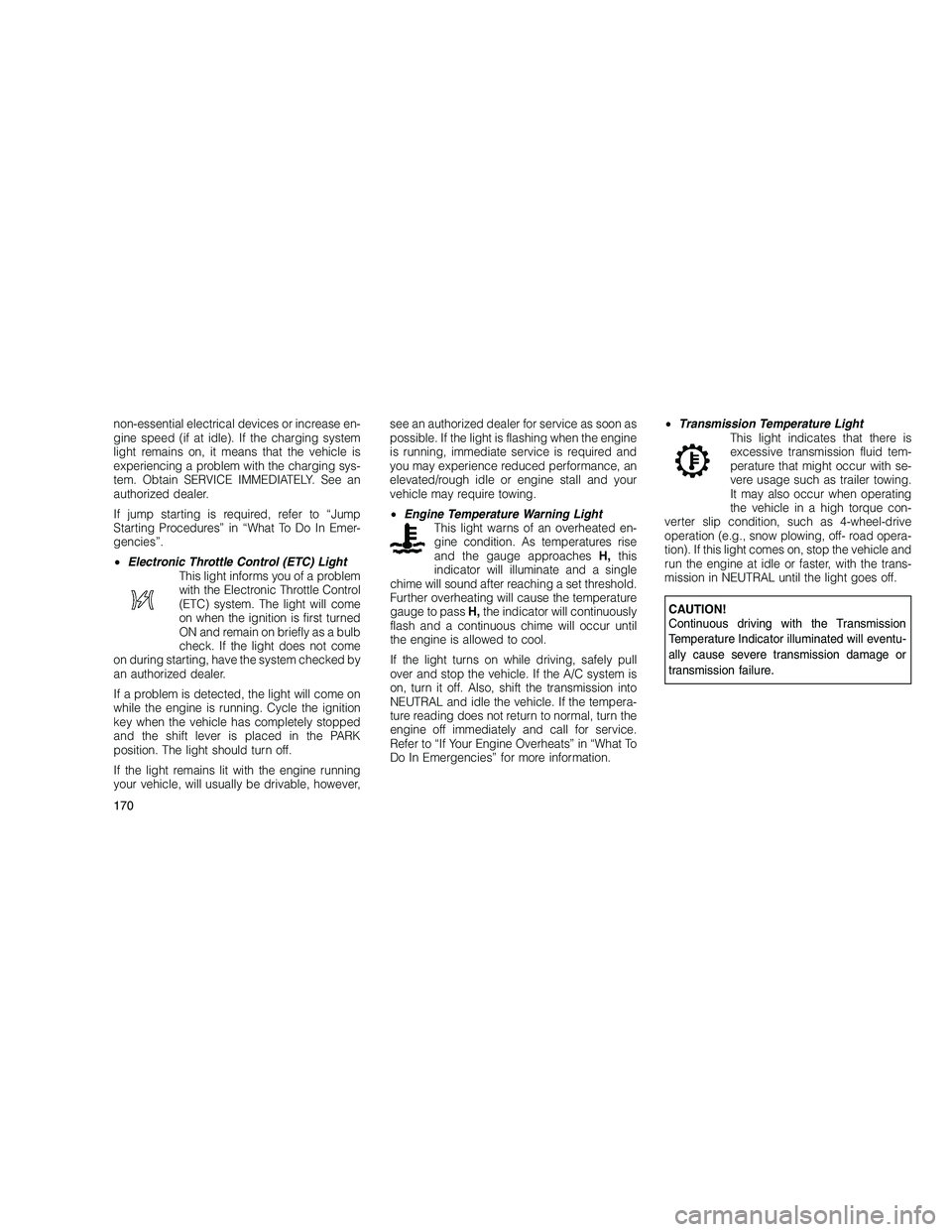
non-essential electrical devices or increase en-
gine speed (if at idle). If the charging system
light remains on, it means that the vehicle is
experiencing a problem with the charging sys-
tem. Obtain SERVICE IMMEDIATELY. See an
authorized dealer.
If jump starting is required, refer to “Jump
Starting Procedures” in “What To Do In Emer-
gencies”.
•Electronic Throttle Control (ETC) Light
This light informs you of a problem
with the Electronic Throttle Control
(ETC) system. The light will come
on when the ignition is first turned
ON and remain on briefly as a bulb
check. If the light does not come
on during starting, have the system checked by
an authorized dealer.
If a problem is detected, the light will come on
while the engine is running. Cycle the ignition
key when the vehicle has completely stopped
and the shift lever is placed in the PARK
position. The light should turn off.
If the light remains lit with the engine running
your vehicle, will usually be drivable, however, see an authorized dealer for service as soon as
possible. If the light is flashing when the engine
is running, immediate service is required and
you may experience reduced performance, an
elevated/rough idle or engine stall and your
vehicle may require towing.
•
Engine Temperature Warning Light
This light warns of an overheated en-
gine condition. As temperatures rise
and the gauge approaches H,this
indicator will illuminate and a single
chime will sound after reaching a set threshold.
Further overheating will cause the temperature
gauge to pass H,the indicator will continuously
flash and a continuous chime will occur until
the engine is allowed to cool.
If the light turns on while driving, safely pull
over and stop the vehicle. If the A/C system is
on, turn it off. Also, shift the transmission into
NEUTRAL and idle the vehicle. If the tempera-
ture reading does not return to normal, turn the
engine off immediately and call for service.
Refer to “If Your Engine Overheats” in “What To
Do In Emergencies” for more information. •
Transmission Temperature Light
This light indicates that there is
excessive transmission fluid tem-
perature that might occur with se-
vere usage such as trailer towing.
It may also occur when operating
the vehicle in a high torque con-
verter slip condition, such as 4-wheel-drive
operation (e.g., snow plowing, off- road opera-
tion). If this light comes on, stop the vehicle and
run the engine at idle or faster, with the trans-
mission in NEUTRAL until the light goes off.
CAUTION!
Continuous driving with the Transmission
Temperature Indicator illuminated will eventu-
ally cause severe transmission damage or
transmission failure.
170
Page 213 of 350
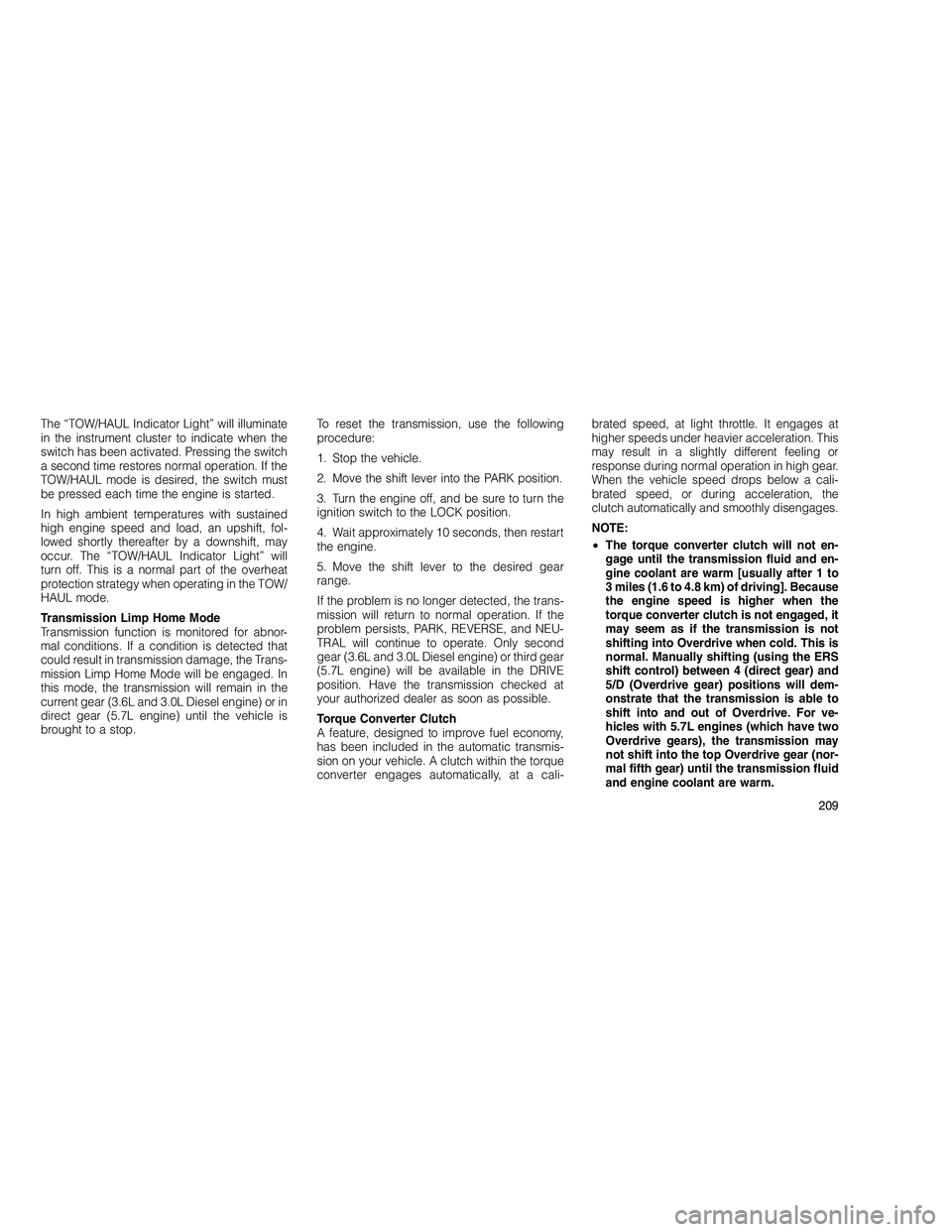
The “TOW/HAUL Indicator Light” will illuminate
in the instrument cluster to indicate when the
switch has been activated. Pressing the switch
a second time restores normal operation. If the
TOW/HAUL mode is desired, the switch must
be pressed each time the engine is started.
In high ambient temperatures with sustained
high engine speed and load, an upshift, fol-
lowed shortly thereafter by a downshift, may
occur. The “TOW/HAUL Indicator Light” will
turn off. This is a normal part of the overheat
protection strategy when operating in the TOW/
HAUL mode.
Transmission Limp Home Mode
Transmission function is monitored for abnor-
mal conditions. If a condition is detected that
could result in transmission damage, the Trans-
mission Limp Home Mode will be engaged. In
this mode, the transmission will remain in the
current gear (3.6L and 3.0L Diesel engine) or in
direct gear (5.7L engine) until the vehicle is
brought to a stop.To reset the transmission, use the following
procedure:
1. Stop the vehicle.
2. Move the shift lever into the PARK position.
3. Turn the engine off, and be sure to turn the
ignition switch to the LOCK position.
4. Wait approximately 10 seconds, then restart
the engine.
5. Move the shift lever to the desired gear
range.
If the problem is no longer detected, the trans-
mission will return to normal operation. If the
problem persists, PARK, REVERSE, and NEU-
TRAL will continue to operate. Only second
gear (3.6L and 3.0L Diesel engine) or third gear
(5.7L engine) will be available in the DRIVE
position. Have the transmission checked at
your authorized dealer as soon as possible.
Torque Converter Clutch
A feature, designed to improve fuel economy,
has been included in the automatic transmis-
sion on your vehicle. A clutch within the torque
converter engages automatically, at a cali-brated speed, at light throttle. It engages at
higher speeds under heavier acceleration. This
may result in a slightly different feeling or
response during normal operation in high gear.
When the vehicle speed drops below a cali-
brated speed, or during acceleration, the
clutch automatically and smoothly disengages.
NOTE:
•
The torque converter clutch will not en-
gage until the transmission fluid and en-
gine coolant are warm [usually after 1 to
3 miles (1.6 to 4.8 km) of driving]. Because
the engine speed is higher when the
torque converter clutch is not engaged, it
may seem as if the transmission is not
shifting into Overdrive when cold. This is
normal. Manually shifting (using the ERS
shift control) between 4 (direct gear) and
5/D (Overdrive gear) positions will dem-
onstrate that the transmission is able to
shift into and out of Overdrive. For ve-
hicles with 5.7L engines (which have two
Overdrive gears), the transmission may
not shift into the top Overdrive gear (nor-
mal fifth gear) until the transmission fluid
and engine coolant are warm.
209
Page 226 of 350
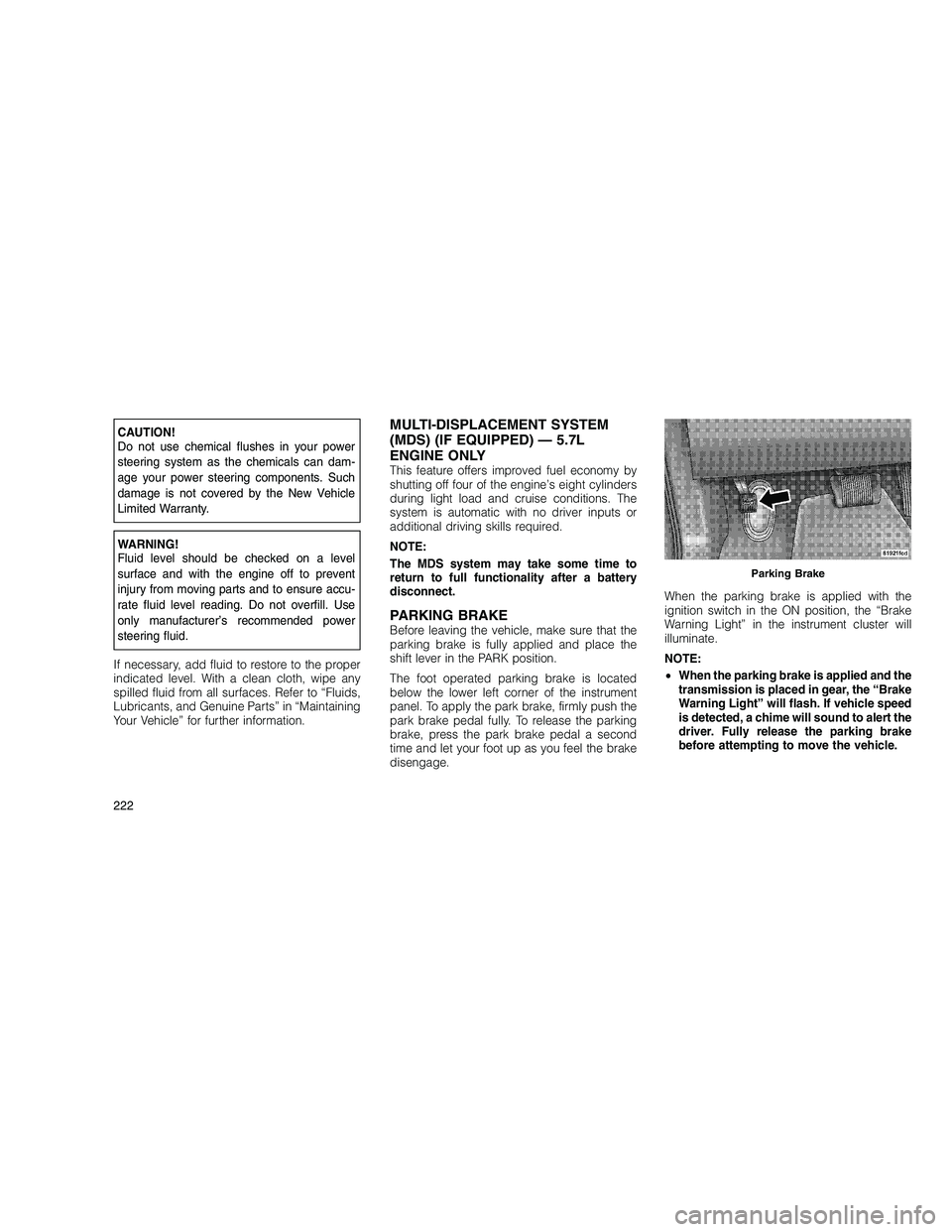
CAUTION!
Do not use chemical flushes in your power
steering system as the chemicals can dam-
age your power steering components. Such
damage is not covered by the New Vehicle
Limited Warranty.
WARNING!
Fluid level should be checked on a level
surface and with the engine off to prevent
injury from moving parts and to ensure accu-
rate fluid level reading. Do not overfill. Use
only manufacturer’s recommended power
steering fluid.
If necessary, add fluid to restore to the proper
indicated level. With a clean cloth, wipe any
spilled fluid from all surfaces. Refer to “Fluids,
Lubricants, and Genuine Parts” in “Maintaining
Your Vehicle” for further information.
MULTI-DISPLACEMENT SYSTEM
(MDS) (IF EQUIPPED) — 5.7L
ENGINE ONLY
This feature offers improved fuel economy by
shutting off four of the engine’s eight cylinders
during light load and cruise conditions. The
system is automatic with no driver inputs or
additional driving skills required.
NOTE:
The MDS system may take some time to
return to full functionality after a battery
disconnect.
PARKING BRAKEBefore leaving the vehicle, make sure that the
parking brake is fully applied and place the
shift lever in the PARK position.
The foot operated parking brake is located
below the lower left corner of the instrument
panel. To apply the park brake, firmly push the
park brake pedal fully. To release the parking
brake, press the park brake pedal a second
time and let your foot up as you feel the brake
disengage. When the parking brake is applied with the
ignition switch in the ON position, the “Brake
Warning Light” in the instrument cluster will
illuminate.
NOTE:
•
When the parking brake is applied and the
transmission is placed in gear, the “Brake
Warning Light” will flash. If vehicle speed
is detected, a chime will sound to alert the
driver. Fully release the parking brake
before attempting to move the vehicle.
Parking Brake
222
Page 254 of 350
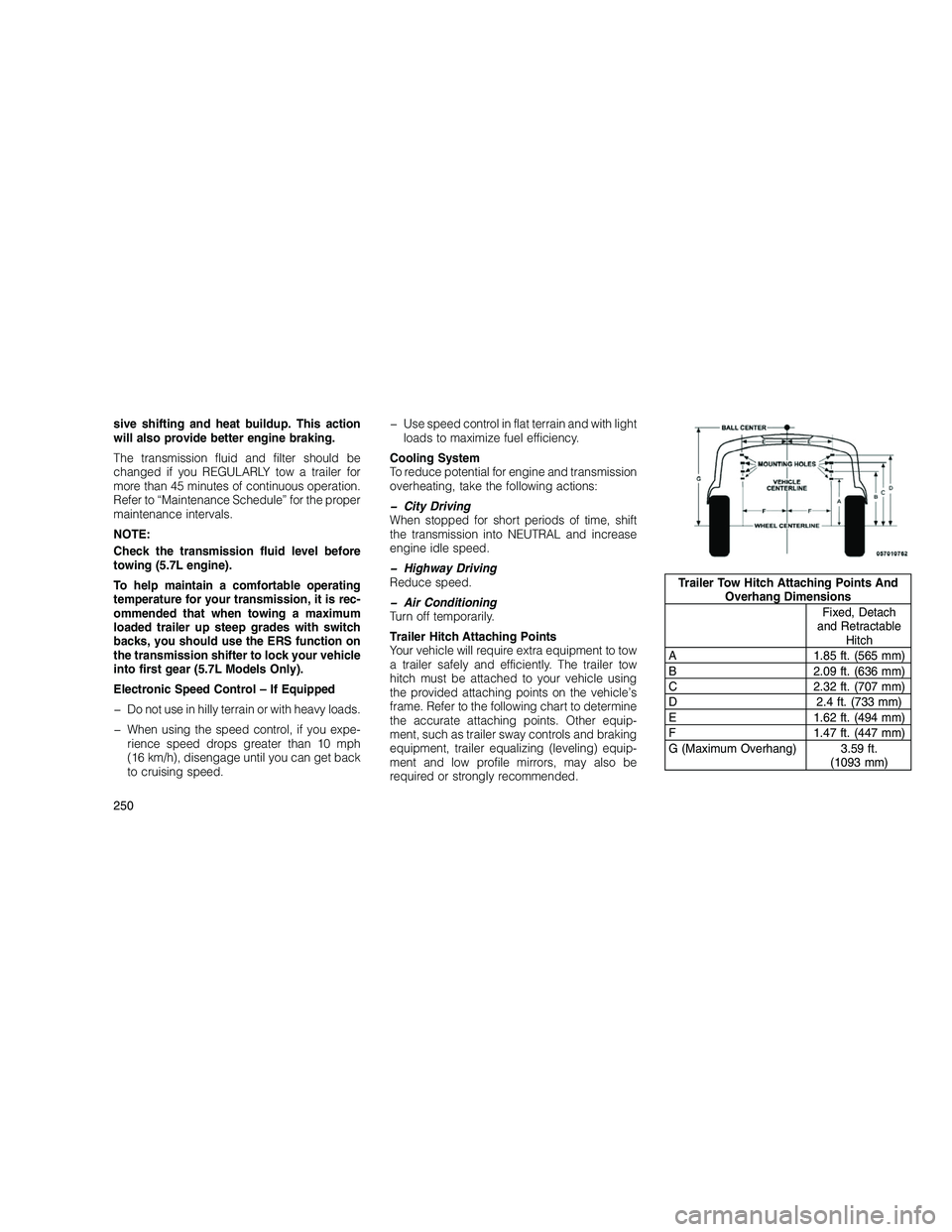
sive shifting and heat buildup. This action
will also provide better engine braking.
The transmission fluid and filter should be
changed if you REGULARLY tow a trailer for
more than 45 minutes of continuous operation.
Refer to “Maintenance Schedule” for the proper
maintenance intervals.
NOTE:
Check the transmission fluid level before
towing (5.7L engine).
To help maintain a comfortable operating
temperature for your transmission, it is rec-
ommended that when towing a maximum
loaded trailer up steep grades with switch
backs, you should use the ERS function on
the transmission shifter to lock your vehicle
into first gear (5.7L Models Only).
Electronic Speed Control – If Equipped
� Do not use in hilly terrain or with heavy loads.
� When using the speed control, if you expe-rience speed drops greater than 10 mph
(16 km/h), disengage until you can get back
to cruising speed. � Use speed control in flat terrain and with light
loads to maximize fuel efficiency.
Cooling System
To reduce potential for engine and transmission
overheating, take the following actions:
� City Driving
When stopped for short periods of time, shift
the transmission into NEUTRAL and increase
engine idle speed.
� Highway Driving
Reduce speed.
� Air Conditioning
Turn off temporarily.
Trailer Hitch Attaching Points
Your vehicle will require extra equipment to tow
a trailer safely and efficiently. The trailer tow
hitch must be attached to your vehicle using
the provided attaching points on the vehicle’s
frame. Refer to the following chart to determine
the accurate attaching points. Other equip-
ment, such as trailer sway controls and braking
equipment, trailer equalizing (leveling) equip-
ment and low profile mirrors, may also be
required or strongly recommended.
Trailer Tow Hitch Attaching Points And Overhang Dimensions
Fixed, Detach
and Retractable Hitch
A 1.85 ft. (565 mm)
B 2.09 ft. (636 mm)
C 2.32 ft. (707 mm)
D 2.4 ft. (733 mm)
E 1.62 ft. (494 mm)
F 1.47 ft. (447 mm)
G (Maximum Overhang) 3.59 ft. (1093 mm)
250
Page 278 of 350
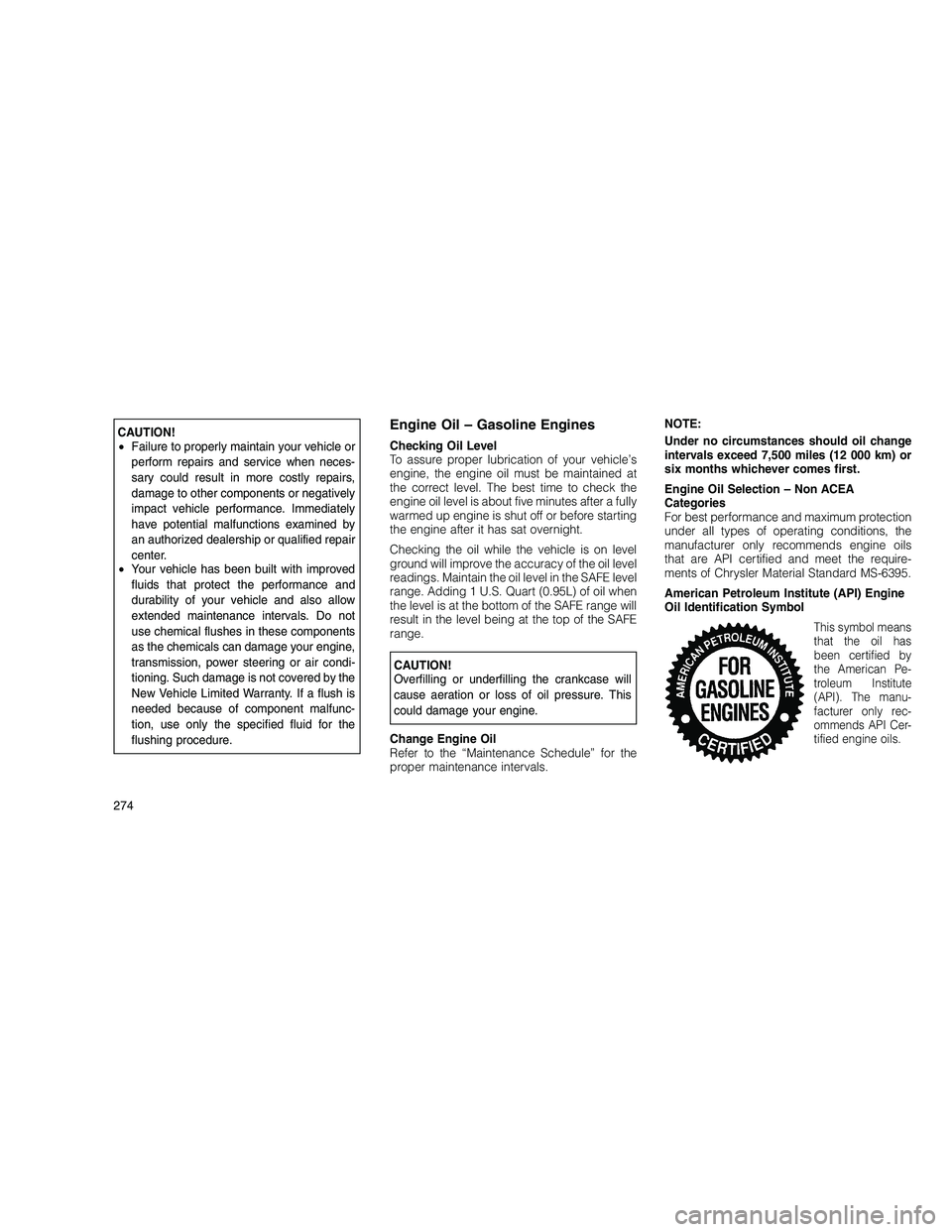
CAUTION!
•Failure to properly maintain your vehicle or
perform repairs and service when neces-
sary could result in more costly repairs,
damage to other components or negatively
impact vehicle performance. Immediately
have potential malfunctions examined by
an authorized dealership or qualified repair
center.
• Your vehicle has been built with improved
fluids that protect the performance and
durability of your vehicle and also allow
extended maintenance intervals. Do not
use chemical flushes in these components
as the chemicals can damage your engine,
transmission, power steering or air condi-
tioning. Such damage is not covered by the
New Vehicle Limited Warranty. If a flush is
needed because of component malfunc-
tion, use only the specified fluid for the
flushing procedure.Engine Oil – Gasoline Engines
Checking Oil Level
To assure proper lubrication of your vehicle’s
engine, the engine oil must be maintained at
the correct level. The best time to check the
engine oil level is about five minutes after a fully
warmed up engine is shut off or before starting
the engine after it has sat overnight.
Checking the oil while the vehicle is on level
ground will improve the accuracy of the oil level
readings. Maintain the oil level in the SAFE level
range. Adding 1 U.S. Quart (0.95L) of oil when
the level is at the bottom of the SAFE range will
result in the level being at the top of the SAFE
range.
CAUTION!
Overfilling or underfilling the crankcase will
cause aeration or loss of oil pressure. This
could damage your engine.
Change Engine Oil
Refer to the “Maintenance Schedule” for the
proper maintenance intervals. NOTE:
Under no circumstances should oil change
intervals exceed 7,500 miles (12 000 km) or
six months whichever comes first.
Engine Oil Selection – Non ACEA
Categories
For best performance and maximum protection
under all types of operating conditions, the
manufacturer only recommends engine oils
that are API certified and meet the require-
ments of Chrysler Material Standard MS-6395.
American Petroleum Institute (API) Engine
Oil Identification Symbol
This symbol means
that the oil has
been certified by
the American Pe-
troleum Institute
(API). The manu-
facturer only rec-
ommends API Cer-
tified engine oils.
274
Page 289 of 350
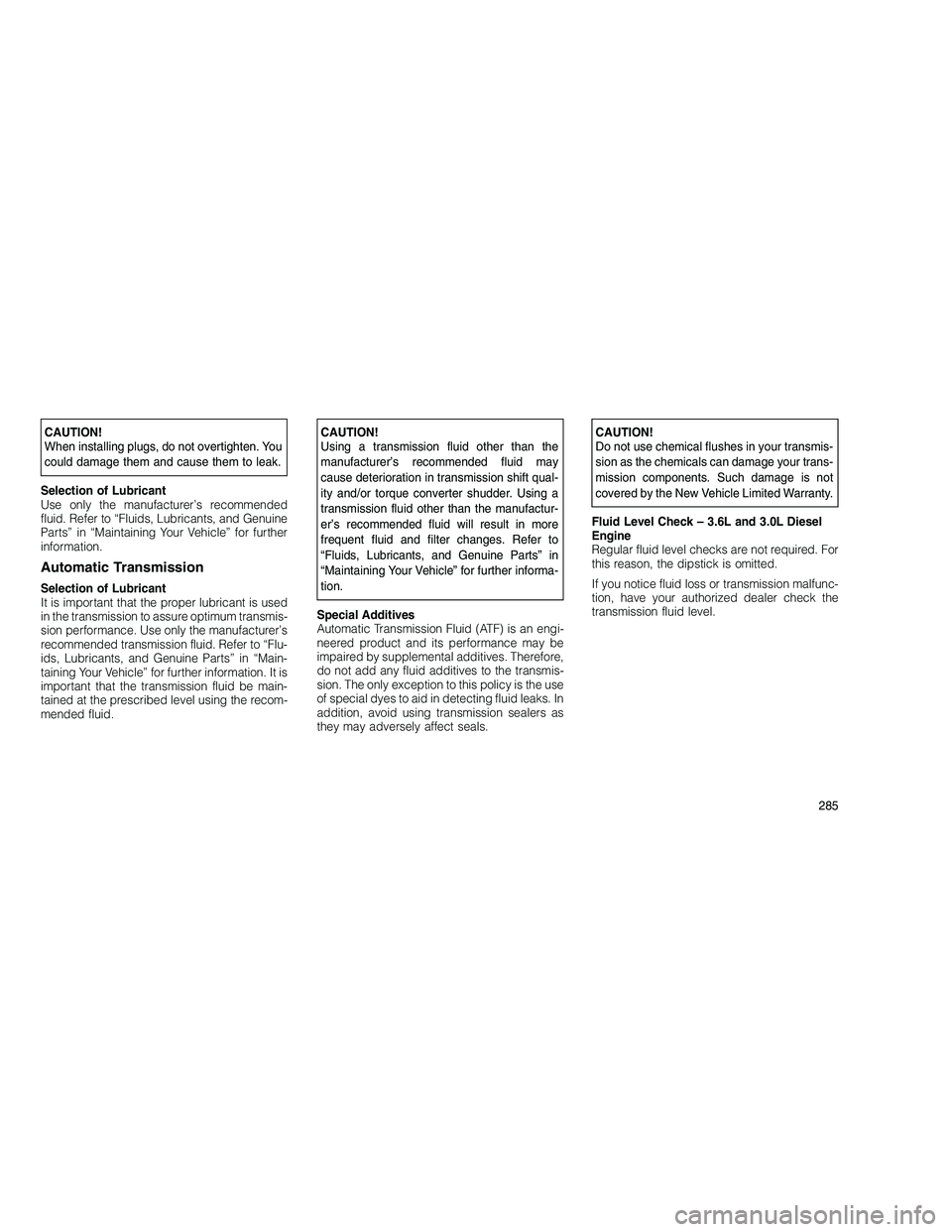
CAUTION!
When installing plugs, do not overtighten. You
could damage them and cause them to leak.
Selection of Lubricant
Use only the manufacturer’s recommended
fluid. Refer to “Fluids, Lubricants, and Genuine
Parts” in “Maintaining Your Vehicle” for further
information.
Automatic Transmission
Selection of Lubricant
It is important that the proper lubricant is used
in the transmission to assure optimum transmis-
sion performance. Use only the manufacturer’s
recommended transmission fluid. Refer to “Flu-
ids, Lubricants, and Genuine Parts” in “Main-
taining Your Vehicle” for further information. It is
important that the transmission fluid be main-
tained at the prescribed level using the recom-
mended fluid.
CAUTION!
Using a transmission fluid other than the
manufacturer’s recommended fluid may
cause deterioration in transmission shift qual-
ity and/or torque converter shudder. Using a
transmission fluid other than the manufactur-
er’s recommended fluid will result in more
frequent fluid and filter changes. Refer to
“Fluids, Lubricants, and Genuine Parts” in
“Maintaining Your Vehicle” for further informa-
tion.
Special Additives
Automatic Transmission Fluid (ATF) is an engi-
neered product and its performance may be
impaired by supplemental additives. Therefore,
do not add any fluid additives to the transmis-
sion. The only exception to this policy is the use
of special dyes to aid in detecting fluid leaks. In
addition, avoid using transmission sealers as
they may adversely affect seals.CAUTION!
Do not use chemical flushes in your transmis-
sion as the chemicals can damage your trans-
mission components. Such damage is not
covered by the New Vehicle Limited Warranty.
Fluid Level Check – 3.6L and 3.0L Diesel
Engine
Regular fluid level checks are not required. For
this reason, the dipstick is omitted.
If you notice fluid loss or transmission malfunc-
tion, have your authorized dealer check the
transmission fluid level.
285
Page 290 of 350
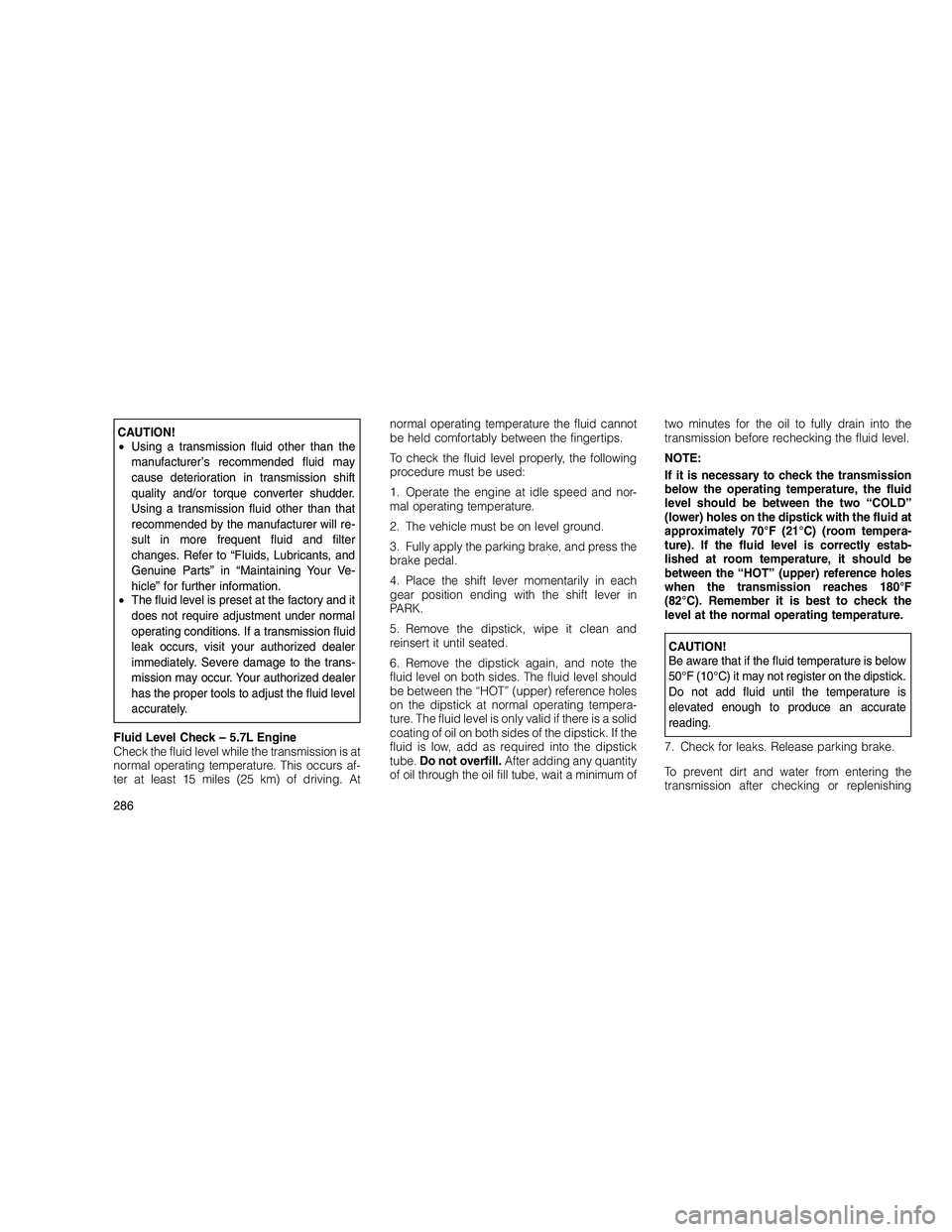
CAUTION!
•Using a transmission fluid other than the
manufacturer’s recommended fluid may
cause deterioration in transmission shift
quality and/or torque converter shudder.
Using a transmission fluid other than that
recommended by the manufacturer will re-
sult in more frequent fluid and filter
changes. Refer to “Fluids, Lubricants, and
Genuine Parts” in “Maintaining Your Ve-
hicle” for further information.
• The fluid level is preset at the factory and it
does not require adjustment under normal
operating conditions. If a transmission fluid
leak occurs, visit your authorized dealer
immediately. Severe damage to the trans-
mission may occur. Your authorized dealer
has the proper tools to adjust the fluid level
accurately.
Fluid Level Check – 5.7L Engine
Check the fluid level while the transmission is at
normal operating temperature. This occurs af-
ter at least 15 miles (25 km) of driving. At normal operating temperature the fluid cannot
be held comfortably between the fingertips.
To check the fluid level properly, the following
procedure must be used:
1. Operate the engine at idle speed and nor-
mal operating temperature.
2. The vehicle must be on level ground.
3. Fully apply the parking brake, and press the
brake pedal.
4. Place the shift lever momentarily in each
gear position ending with the shift lever in
PARK.
5. Remove the dipstick, wipe it clean and
reinsert it until seated.
6. Remove the dipstick again, and note the
fluid level on both sides. The fluid level should
be between the “HOT” (upper) reference holes
on the dipstick at normal operating tempera-
ture. The fluid level is only valid if there is a solid
coating of oil on both sides of the dipstick. If the
fluid is low, add as required into the dipstick
tube.
Do not overfill. After adding any quantity
of oil through the oil fill tube, wait a minimum of two minutes for the oil to fully drain into the
transmission before rechecking the fluid level.
NOTE:
If it is necessary to check the transmission
below the operating temperature, the fluid
level should be between the two “COLD”
(lower) holes on the dipstick with the fluid at
approximately 70°F (21°C) (room tempera-
ture). If the fluid level is correctly estab-
lished at room temperature, it should be
between the “HOT” (upper) reference holes
when the transmission reaches 180°F
(82°C). Remember it is best to check the
level at the normal operating temperature.
CAUTION!
Be aware that if the fluid temperature is below
50°F (10°C) it may not register on the dipstick.
Do not add fluid until the temperature is
elevated enough to produce an accurate
reading.
7. Check for leaks. Release parking brake.
To prevent dirt and water from entering the
transmission after checking or replenishing
286
Page 306 of 350
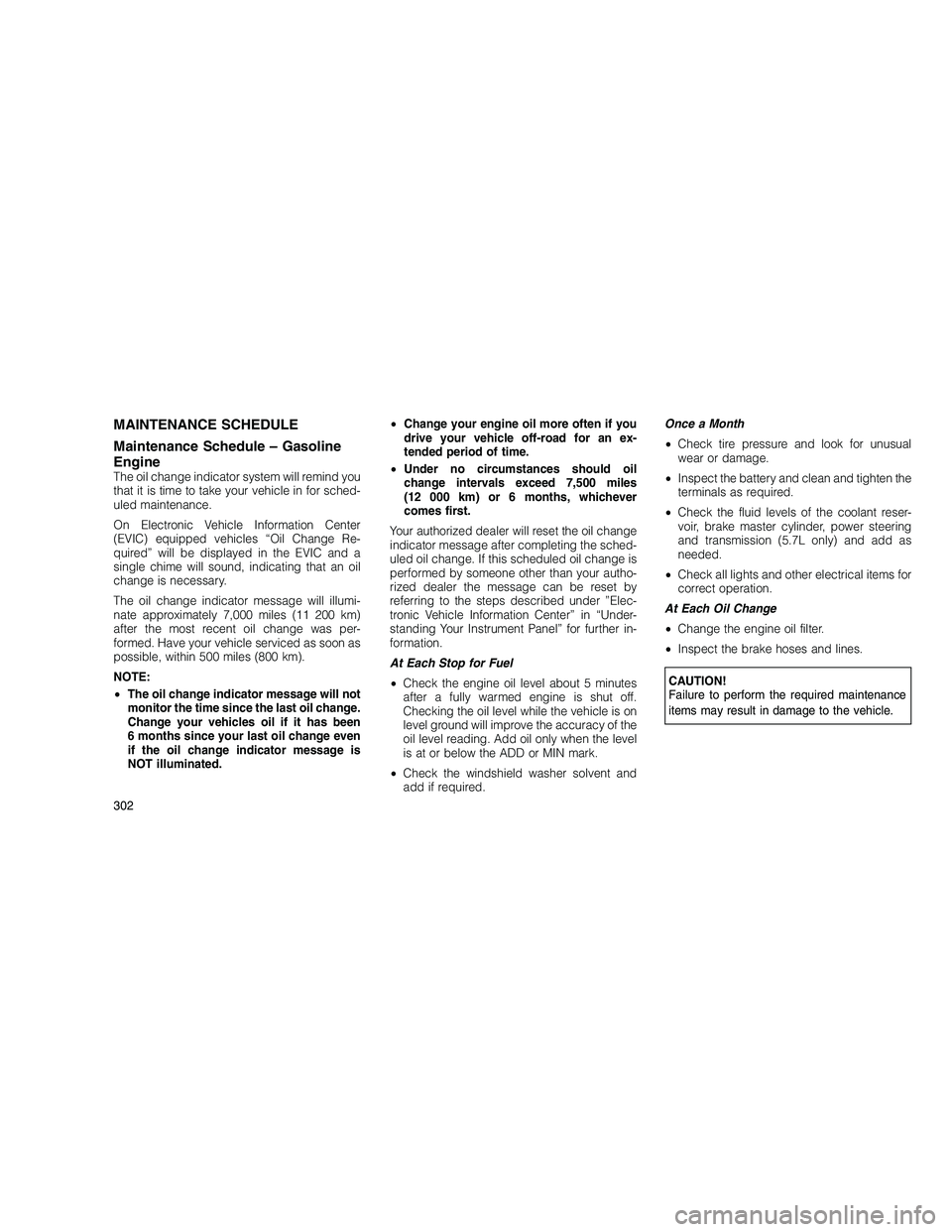
MAINTENANCE SCHEDULE
Maintenance Schedule – Gasoline
Engine
The oil change indicator system will remind you
that it is time to take your vehicle in for sched-
uled maintenance.
On Electronic Vehicle Information Center
(EVIC) equipped vehicles “Oil Change Re-
quired” will be displayed in the EVIC and a
single chime will sound, indicating that an oil
change is necessary.
The oil change indicator message will illumi-
nate approximately 7,000 miles (11 200 km)
after the most recent oil change was per-
formed. Have your vehicle serviced as soon as
possible, within 500 miles (800 km).
NOTE:
•The oil change indicator message will not
monitor the time since the last oil change.
Change your vehicles oil if it has been
6 months since your last oil change even
if the oil change indicator message is
NOT illuminated. •
Change your engine oil more often if you
drive your vehicle off-road for an ex-
tended period of time.
• Under no circumstances should oil
change intervals exceed 7,500 miles
(12 000 km) or 6 months, whichever
comes first.
Your authorized dealer will reset the oil change
indicator message after completing the sched-
uled oil change. If this scheduled oil change is
performed by someone other than your autho-
rized dealer the message can be reset by
referring to the steps described under ”Elec-
tronic Vehicle Information Center” in “Under-
standing Your Instrument Panel” for further in-
formation.
At Each Stop for Fuel
• Check the engine oil level about 5 minutes
after a fully warmed engine is shut off.
Checking the oil level while the vehicle is on
level ground will improve the accuracy of the
oil level reading. Add oil only when the level
is at or below the ADD or MIN mark.
• Check the windshield washer solvent and
add if required. Once a Month
•
Check tire pressure and look for unusual
wear or damage.
• Inspect the battery and clean and tighten the
terminals as required.
• Check the fluid levels of the coolant reser-
voir, brake master cylinder, power steering
and transmission (5.7L only) and add as
needed.
• Check all lights and other electrical items for
correct operation.
At Each Oil Change
• Change the engine oil filter.
• Inspect the brake hoses and lines.
CAUTION!
Failure to perform the required maintenance
items may result in damage to the vehicle.
302
Page 340 of 350
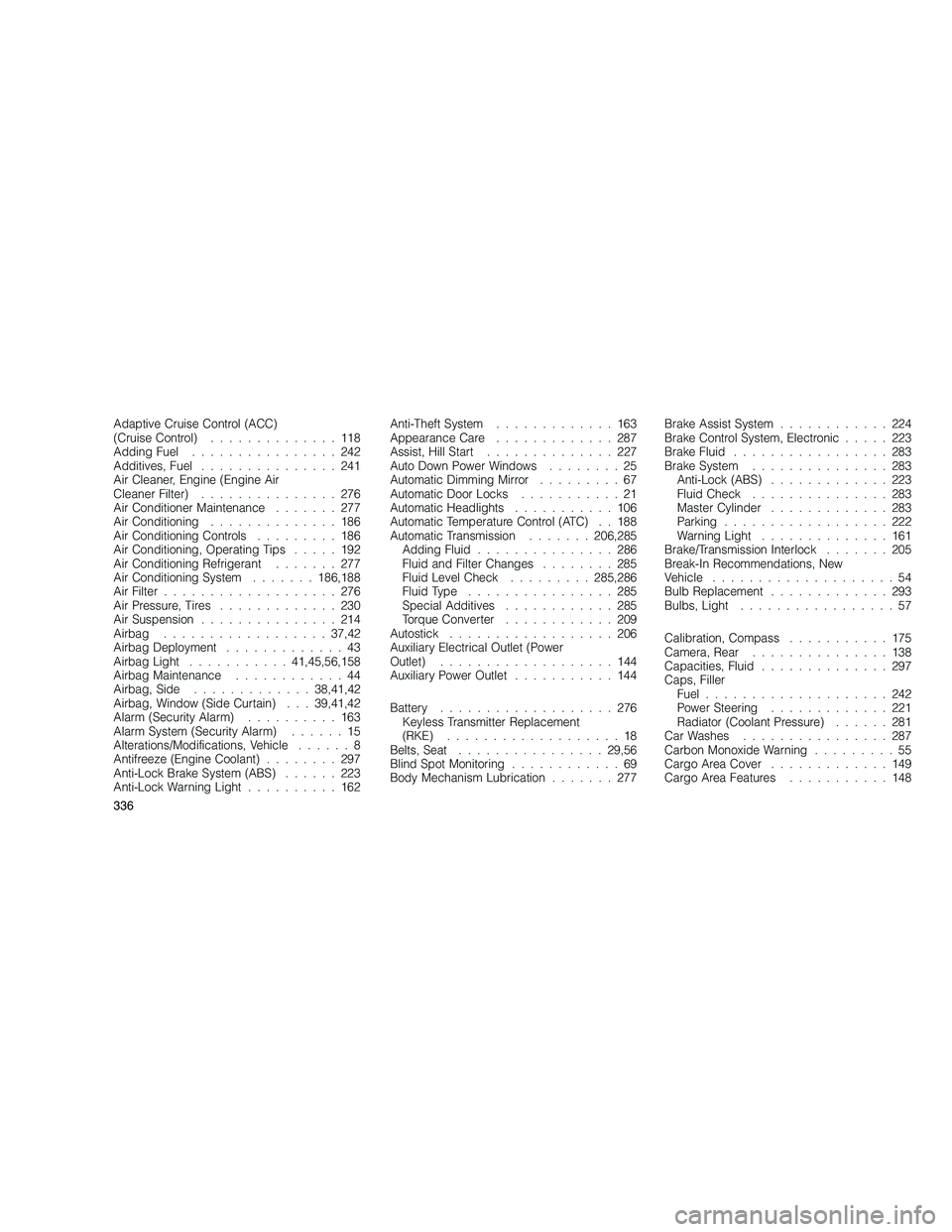
Adaptive Cruise Control (ACC)
(Cruise Control)..............118
Adding Fuel ................242
Additives, Fuel ...............241
Air Cleaner, Engine (Engine Air
Cleaner Filter) ...............276
Air Conditioner Maintenance .......277
Air Conditioning ..............186
Air Conditioning Controls .........186
Air Conditioning, Operating Tips .....192
Air Conditioning Refrigerant .......277
Air Conditioning System .......186,188
Air Filter ...................276
Air Pressure, Tires .............230
Air Suspension ...............214
Airbag .................. 37,42
Airbag Deployment .............43
Airbag Light ........... 41,45,56,158
Airbag Maintenance ............44
Airbag, Side ............. 38,41,42
Airbag, Window (Side Curtain) . . . 39,41,42
Alarm (Security Alarm) ..........163
Alarm System (Security Alarm) ......15
Alterations/Modifications, Vehicle ......8
Antifreeze (Engine Coolant) ........297
Anti-Lock Brake System (ABS) ......223
Anti-Lock Warning Light ..........162 Anti-Theft System
.............163
Appearance Care .............287
Assist, Hill Start ..............227
Auto Down Power Windows ........25
Automatic Dimming Mirror .........67
Automatic Door Locks ...........21
Automatic Headlights ...........106
Automatic Temperature Control (ATC) . . 188
Automatic Transmission .......206,285
Adding Fluid ...............286
Fluid and Filter Changes ........285
Fluid Level Check .........285,286
Fluid Type ................285
Special Additives ............285
Torque Converter ............209
Autostick ..................206
Auxiliary Electrical Outlet (Power
Outlet) ...................144
Auxiliary Power Outlet ...........144
Battery ...................276
Keyless Transmitter Replacement
(RKE) ...................18
Belts, Seat ................ 29,56
Blind Spot Monitoring ............69
Body Mechanism Lubrication .......277Brake Assist System............224
Brake Control System, Electronic .....223
Brake Fluid .................283
Brake System ...............283
Anti-Lock (ABS) .............223
Fluid Check ...............283
Master Cylinder .............283
Parking ..................222
Warning Light ..............161
Brake/Transmission Interlock .......205
Break-In Recommendations, New
Vehicle ....................54
Bulb Replacement .............293
Bulbs, Light .................57
Calibration, Compass ...........175
Camera, Rear ...............138
Capacities, Fluid ..............297
Caps, Filler Fuel ....................242
Power Steering .............221
Radiator (Coolant Pressure) ......281
Car Washes ................287
Carbon Monoxide Warning .........55
Cargo Area Cover .............149
Cargo Area Features ...........148
336
Page 342 of 350
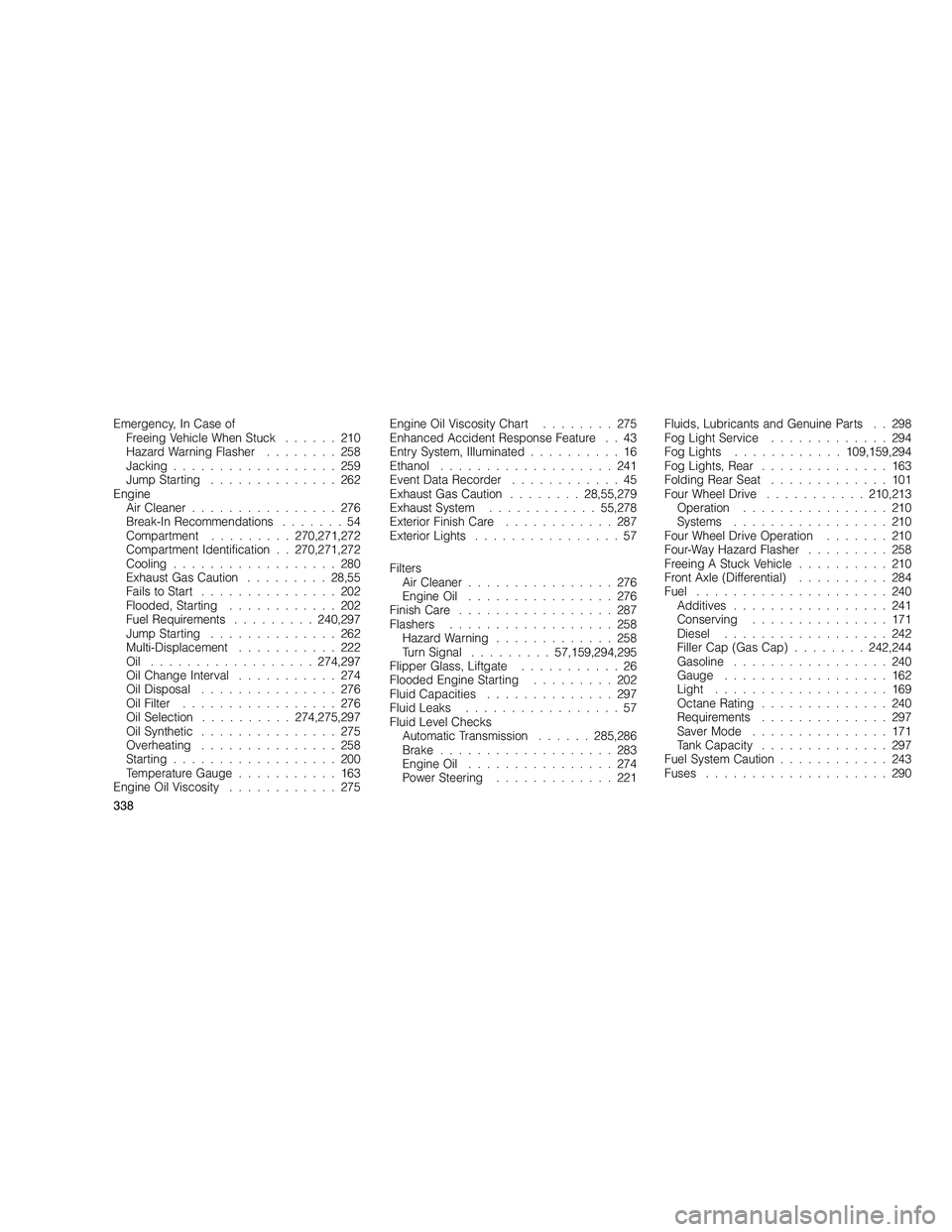
Emergency, In Case ofFreeing Vehicle When Stuck ......210
Hazard Warning Flasher ........258
Jacking ..................259
Jump Starting ..............262
Engine Air Cleaner ................276
Break-In Recommendations .......54
Compartment .........270,271,272
Compartment Identification . . 270,271,272
Cooling ..................280
Exhaust Gas Caution .........28,55
Fails to Start ...............202
Flooded, Starting ............202
Fuel Requirements .........240,297
Jump Starting ..............262
Multi-Displacement ...........222
Oil .................. 274,297
Oil Change Interval ...........274
Oil Disposal ...............276
Oil Filter .................276
Oil Selection .......... 274,275,297
Oil Synthetic ...............275
Overheating ...............258
Starting ..................200
Temperature Gauge ...........163
Engine Oil Viscosity ............275 Engine Oil Viscosity Chart
........275
Enhanced Accident Response Feature . . 43
Entry System, Illuminated ..........16
Ethanol ...................241
Event Data Recorder ............45
Exhaust Gas Caution ........28,55,279
Exhaust System ............ 55,278
Exterior Finish Care ............287
Exterior Lights ................57
Filters Air Cleaner ................276
Engine Oil ................276
Finish Care .................287
Flashers ..................258
Hazard Warning .............258
Turn Signal ......... 57,159,294,295
Flipper Glass, Liftgate ...........26
Flooded Engine Starting .........202
Fluid Capacities ..............297
Fluid Leaks .................57
Fluid Level Checks Automatic Transmission ......285,286
Brake ...................283
Engine Oil
................274
Power Steering .............221 Fluids, Lubricants and Genuine Parts . . 298
Fog Light Service
.............294
Fog Lights ............ 109,159,294
Fog Lights, Rear ..............163
Folding Rear Seat .............101
Four Wheel Drive ........... 210,213
Operation ................210
Systems .................210
Four Wheel Drive Operation .......210
Four-Way Hazard Flasher .........258
Freeing A Stuck Vehicle ..........210
Front Axle (Differential) ..........284
Fuel .....................240
Additives .................241
Conserving ...............171
Diesel ..................242
Filler Cap (Gas Cap) ........242,244
Gasoline .................240
Gauge ..................162
Light ...................169
Octane Rating ..............240
Requirements ..............297
Saver Mode ...............171
Tank Capacity ..............297
Fuel System Caution ............243
Fuses ....................290
338